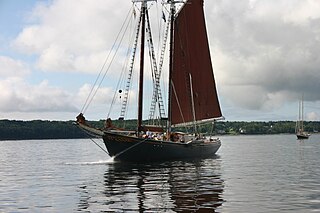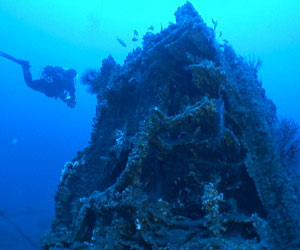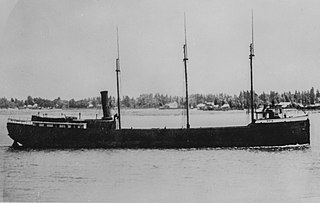
A U.S. National Marine Sanctuary is a zone within United States waters where the marine environment enjoys special protection. The program began in 1972 in response to public concern about the plight of marine ecosystems.
SS Cotopaxi was an Emergency Fleet Corporation (EFC) Design 1060 bulk carrier built for the United States Shipping Board (USSB) under the World War I emergency shipbuilding program. The ship, launched 15 November 1918, was named after the Cotopaxi stratovolcano of Ecuador. The ship arrived in Boston, 22 December 1918, to begin operations for the USSB, through 23 December 1919, when Cotopaxi was delivered to the Clinchfield Navigation Company under terms of sale.

San Pedro Underwater Archaeological Preserve State Park is a Florida State Park located in 18 feet (5.5 m) of water, approximately 1.25 nautical miles (2.32 km) south of Indian Key. It became the second Florida Underwater Archaeological Preserve when it opened to the public in 1989. The heart of the park is the San Pedro, a submerged shipwreck from a 1733 Spanish flotilla, around which visitors can dive and snorkel. The San Pedro, a 287-ton Dutch-built vessel, and 21 other Spanish ships under the command of Rodrigo de Torres left Havana, Cuba, on Friday, July 13, 1733, bound for Spain. The San Pedro carried a cargo of 16,000 silver Mexican pesos and crates of Chinese porcelain. A hurricane struck the fleet, while entering the Straits of Florida, and sank or swamped most of the fleet. The wrecksite includes an "eighteenth century anchor, replica cannons, ballast stones encrusted with coral, a dedication plaque, and a mooring buoy system." The wreck was added to the U.S. National Register of Historic Places on May 31, 2001.

SS Winfield Scott was a sidewheel steamer that transported passengers and cargo between San Francisco, California and Panama in the early 1850s, during the California Gold Rush. After entering a heavy fog off the coast of Southern California on the evening of December 1, 1853, the ship crashed into Middle Anacapa Island. All 450 passengers and crew survived, but the ship was lost.

The Portland Gale was a storm that struck the coast of New England on November 26 and 27, 1898. The storm formed when two low pressure areas merged off the coast of Virginia and travelled up the coast; at its peak, it produced a storm surge of about ten feet in Cohasset harbor and hurricane-force winds in Nantucket. The storm killed more than 400 people and sank more than 150 boats and ships. It also changed the course of the North River, separating the Humarock portion of Scituate, Massachusetts, from the rest of Scituate.

Stellwagen Bank National Marine Sanctuary is an 842-square-mile (638-square-nautical-mile) federally protected marine sanctuary located at the mouth of Massachusetts Bay, between Cape Cod and Cape Ann. It is known as an excellent whale watching site, and is home to many other species of marine life.

The Lofthus is a Norwegian shipwreck near Boynton Beach, Florida, United States. Built in 1868 in Sunderland, England, the iron-hulled vessel was originally christened Cashmere and rigged as a three masted barque. She was equipped with false gun ports to ward off pirates. After a career in the East Indian trade Cashmere was sold to a Norwegian firm, renamed Lofthus, and used in the American trade. She was sunk in a terrible storm on February 4, 1898, en route to Buenos Aires. Her crew of 16 and the ship's cat and dog were rescued by the passing vessel Three Friends, which was smuggling guns to Cuba. The wreck of the Lofthus is located three-quarters of a mile north of Boynton Inlet, 175 yards offshore from Manalapan. On January 6, 2004, it was added to the U.S. National Register of Historic Places. It also became the eighth Florida Underwater Archaeological Preserve the same year.

Adventure is a gaff rigged knockabout schooner. She was built in Essex, Massachusetts, USA, and launched in 1926 to work the Grand Banks fishing grounds out of Gloucester. She is one of only two surviving knockabout fishing schooners – ships designed without bowsprits for the safety of her crew.

Lettie G. Howard, formerly Mystic C and Caviare, is a wooden Fredonia schooner built in 1893 in Essex, Massachusetts, USA. This type of craft was commonly used by American offshore fishermen, and is believed to be the last surviving example of its type. She was declared a National Historic Landmark in 1989. She is now based at the South Street Seaport Museum in New York City.

L. A. Dunton is a National Historic Landmark fishing schooner and museum exhibit located at the Mystic Seaport Museum in Mystic, Connecticut. Built in 1921, she is one of three remaining vessels afloat of this type, which was once the most common sail-powered fishing vessel sailing from New England ports. In service in New England waters until the 1930s and Newfoundland into the 1950s. After a brief period as a cargo ship, she was acquired by the museum and restored to her original condition.

The Paul Palmer was a five-masted schooner built in 1902 by George F. Welt in Waldoboro, Maine.

Roseway is a wooden gaff-rigged schooner launched on 24 November 1925 in Essex, Massachusetts. She is currently operated by World Ocean School, a non-profit educational organization based in Camden, Maine, and is normally operated out of Boston, Massachusetts and Saint Croix, U.S. Virgin Islands. She was designated a National Historic Landmark in 1997 as the only known surviving example of a fishing schooner built specifically with racing competition as an objective.

Monitor National Marine Sanctuary is the site of the wreck of the USS Monitor, one of the most famous shipwrecks in U.S. history. It was designated as the country's first national marine sanctuary on January 30, 1975, and is one of only two of the sixteen national marine sanctuaries created to protect a cultural resource rather than a natural resource. The sanctuary comprises a column of water 1 nautical mile (1.9 km) in diameter extending from the ocean’s surface to the seabed around the wreck of the Civil War ironclad, which lies 16 nautical miles (30 km) south-southeast of Cape Hatteras, North Carolina. Average water depth in the sanctuary is 230 feet (70 m). Since its sinking in 1862, the Monitor has become an artificial reef attracting numerous fish species, including amberjack, black sea-bass, oyster toadfish and great barracuda.

Frank A. Palmer and Louise B. Crary are a historic dual shipwreck site in the Stellwagen Bank National Marine Sanctuary, off Gloucester, Massachusetts.

PS Portland was a large side-wheel paddle steamer, an ocean-going steamship with side-mounted paddlewheels. She was built in 1889 for passenger service between Boston, Massachusetts, and Portland, Maine. She is best known as the namesake of the infamous Portland Gale of 1898, a massive blizzard that struck coastal New England, claiming the lives of over 400 people and more than 150 vessels.

The F.T. Barney was a 19th-century American schooner that sank in 1868. Her wreck in Lake Huron near Rogers City, Michigan, was listed on the National Register of Historic Places in 1991.

The Lamartine is a 19th-century shipwreck lying in the waters of the Stellwagen Bank National Marine Sanctuary, off Gloucester, Massachusetts. She was a schooner built in 1848 in Camden, Maine. She was hauling quarried granite from Stonington, Maine to New York City when she went down in a storm on May 17, 1893. One crewmember drowned; the others were rescued by a fishing vessel that saw the ship sinking. The wreck was located in 2004 by a survey team, documented over the next two years.

The Joffre is a 20th-century shipwreck lying in the waters of the Stellwagen Bank National Marine Sanctuary, off Gloucester, Massachusetts. She was a schooner built in 1912 in Essex, Massachusetts. Active in the Gloucester fishery, she first used tub trawls for fishing, and was converted to an eastern rig dragger and motorized in 1939. She was returning to Gloucester when her engine caught fire on the evening of August 9, 1947. The wheelhouse was engulfed, the crew abandoned ship, and she sank the next day. The wreck was documented by a Stellwagen Bank survey team in 2006.

SS Choctaw was an steel-hulled American freighter in service between 1892 and 1915, on the Great Lakes of North America. She was a so-called monitor vessel, containing elements of traditional lake freighters and the whaleback ships designed by Alexander McDougall. Choctaw was built in 1892 by the Cleveland Shipbuilding Company in Cleveland, Ohio, and was originally owned by the Lake Superior Iron Company. She was sold to the Cleveland-Cliffs Iron Company in 1894 and spent the rest of her working life with it.

SS Ohio was a wooden hulled Great Lakes freighter that served on the Great Lakes of North America from her construction in 1875, to her sinking in September 1894 when she collided with the schooner barge Ironton which also sank in the collision. Ironton was being towed by the steamer Charles J. Kershaw, which was also towing the schooner Moonlight. Ohio was found upright in 2017, over 122 years after her sinking in over 200 feet of water off Presque Isle, Michigan. Ironton is still missing. The researchers who discovered Ohio plan to nominate her for a listing in the National Register of Historic Places.




















